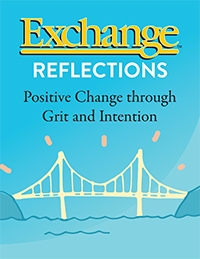ExchangeEveryDay Past Issues
 << Previous Issue
| View Past Issues | | Next Issue >>
<< Previous Issue
| View Past Issues | | Next Issue >> -Katherine Johnson, NASA mathematician, 1918-2020
“We use spatial skills in everyday life, whether following a diagram to put together a piece of furniture, doing a jigsaw puzzle, interpreting a graph in a news article, or navigating through buildings and neighborhoods…Importantly, all students can improve their spatial skills through practice,” writes Elizabeth Gunderson on edutopia.org, “One study estimated that if all U.S. students received spatial skills training, twice as many students would have the spatial skills of a typical engineering student.”
Dimensions Educational Research Foundation notes, “Through their visual-spatial work children are able to explore and manipulate three-dimensional materials, developing and practicing many different skills simultaneously (e.g., construction, engineering, kinesthetic, math, literacy, social skills). They are also communicating their knowledge of the world, often before they have the ability to verbalize it, and learning to communicate, process and manage emotions. Children’s visual-spatial work is a language.”
Children employ and explore visual-spatial skills from the start, especially with the thoughtful support of observant and responsive adults. In the Exchange Reflections “Encouraging Curiosity in Toddlers,” Candace Kastrup writes, “At the start of the school year my class of 15- to 19-month-olds took great pride in moving and pushing our child-sized chairs around the classroom. These standard plastic chairs with metal legs become so much more than a place to sit, taking on roles of trains, buses, tunnels and doll beds… I asked myself, ‘What is it about these chairs that draws my toddlers to them? What is happening as they push?’… I set the intention to provide materials on both a small and large scale to help explore these questions.”
 May not be combined with any other offer. Not valid on bulk purchase discounts. |
ExchangeEveryDay
Delivered five days a week containing news, success stories, solutions, trend reports, and much more.
What is ExchangeEveryDay?
ExchangeEveryDay is the official electronic newsletter for Exchange Press. It is delivered five days a week containing news stories, success stories, solutions, trend reports, and much more.


Comments (4)
Displaying All 4 CommentsExchange Press
Eugene, OR, United States
Wow, Gary, I'm going to look up Tom's blog for sure! Thanks!
Exchange Press
Eugene, OR, United States
So well said, Shawna! I love how you say, "being able to support the fullness of children's development" — a worthy framework for all of us! (My mom was a preschool teacher, too! Many fond memories of learning with and from her!)
Guidecraft
Warwick, NY, United States
Another great article - thank you Exchange. It brought to mind Tom Bedard's blog [http://tomsensori.blogspot.com/], which covers this topic intimately over the course of his teaching for many years. His works explores and documents how young children, but really anyone at any age, learns kinesthetically. I don't know how widely known he is, but I find his work to be fascinating on so many levels, so recommend it for further reading, and sharing!
Learning and Growing Consulting
Carrboro , NC, United States
As an adult who now teaches ECE teachers about how they can moderate children’s development in classrooms, I jokingly tease that my mom (who was my preschool teacher too) is the reason I can’t recognize when a large piece of furniture doesn’t fit into a small or awkward space.
This article reminds me to also share the simple ways we can offer children opportunities to explore visual spatial awareness - letting toddlers see if they can fit in spaces around the room, giving them toys to put in containers of varying sizes, letting the move and stack normal items around the room, and (of course) playing with blocks (something I didn’t do too much of when I was a young child).
Being able to support the fullness of children’s development needs equal parts knowledge of development, quality materials, and adults who can maintain engagement like an air traffic controller.
SD
Post a Comment